
The Berlin S-Bahn is a rapid transit railway system in and around Berlin, the capital city of Germany. It has been in operation under this name since December 1930, having been previously called the special tariff area Berliner Stadt-, Ring- und Vorortbahnen. It complements the Berlin U-Bahn and is the link to many outer-Berlin areas, such as Berlin Brandenburg Airport. As such, the Berlin S-Bahn blends elements of a commuter rail service and a rapid transit system.

The S1 is a railway service of the Berlin S-Bahn that operates between Wannsee and Oranienburg.

S3 is a line on the Berlin S-Bahn. It operates from Erkner to Spandau. For most of its existence since becoming a numbered route in 1984, the S3's line colour is blue.
S9 is a line on the Berlin S-Bahn. It operates from Flughafen BER to Spandau through Berlin Hauptbahnhof over:
S7 is a line on the Berlin S-Bahn. It operates from Ahrensfelde to Potsdam over:
The S86 was a line number used by the Berlin S-Bahn.

The S10 was a line number used by the Berlin S-Bahn from June 1991 until December 1999. The line operated solely in the former East Berlin and was replaced by the S8 for the northern part of the route and the S47/S9 for the southern routing.

Berlin Südkreuz station is a railway station in the German capital Berlin. The station was originally opened in 1898 and is an interchange station. The Berlin Ringbahn line of the Berlin S-Bahn metro railway is situated on the upper level and connects to the east and west, whilst the Anhalter Bahn and Dresdner Bahn intercity railway routes reach the station on the lower, north-south level. The station was extensively rebuilt between the late 1990s and 2006, and was renamed Berlin Südkreuz on 28 May 2006.
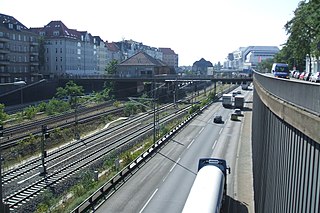
The Ringbahn is a 37.5 km (23.3 mi) long circle route around Berlin's inner city area, on the Berlin S-Bahn network. Its course is made up of a pair of tracks used by S-Bahn trains and another parallel pair of tracks used by various regional, long distance and freight trains. The S-Bahn lines S41 and S42 provide a closed-loop continuous service without termini. Lines S45, S46 and S47 use a section of the southern and western ring, while lines S8 and S85 use sections of the eastern ring. The combined number of passengers is about 400,000 passengers a day. Due to its distinctive shape, the line is often referred to as the Hundekopf.

Berlin Gesundbrunnen station is a railway station in Berlin, Germany. It is situated in the Gesundbrunnen district, part of the central Mitte borough, as an interconnection point between the northern Ringbahn and Nord-Süd Tunnel lines of the Berlin S-Bahn, as well as a regional and long distance station of the Deutsche Bahn network. The station is operated by the DB Station&Service subsidiary of Deutsche Bahn AG and is classified as a Category 1 station, one of 21 in Germany and four in Berlin, the others being Berlin Hauptbahnhof, Berlin Südkreuz and Berlin Ostbahnhof.

Berlin-Spandau station is a Deutsche Bahn station in the Berlin district of Spandau on the south-western edge of the old town of Spandau. The railway junction station is one of the 80 stations classified by Deutsche Bahn as a category 2 station. It has the longest train shed in Germany.

Birkenwerder is a railway station in the town of Birkenwerder, Brandenburg, Germany. The station lies of the Berlin Northern Railway and the train services are operated by Deutsche Bahn including Berlin S-Bahn services.
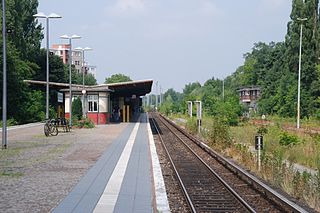
Berlin-Schönholz railway station is a railway station in Berlin, Germany. It is located on the Berlin Northern Railway line in the district of Reinickendorf, though it is named after the adjacent Schönholz quarter of the neighbouring Pankow district. From here, the Kremmen Railway branch line leads to Hennigsdorf and Kremmen. The station is served by S-Bahn trains and local bus lines, and is protected as a listed monument.

The Berlin Northern Railway is a 223-kilometre-long main line route, that runs from Berlin via Neustrelitz and Neubrandenburg to Stralsund on the Baltic Sea coast. Nowadays, long-distance and regional traffic on the Nordbahn is routed at Hohen Neuendorf onto the Berlin Outer Ring to the Karower Kreuz and on to Berlin Main Station or Berlin-Lichtenberg.

Berlin-Lichtenrade station is a station on the Berlin–Dresden railway in the locality of Lichtenrade in the Berlin borough of Tempelhof-Schöneberg. It is served by Berlin S-Bahn line S2.
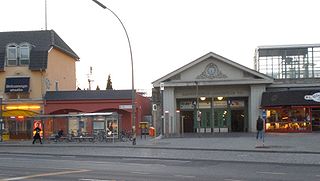
Berlin-Lichterfelde Ost station is on the Anhalt Suburban Line in Lichterfelde in the Berlin borough of Steglitz-Zehlendorf. It is served by S-Bahn line S25, S-Bahn line S26, and Regional-Express lines 3, 4 and 5.
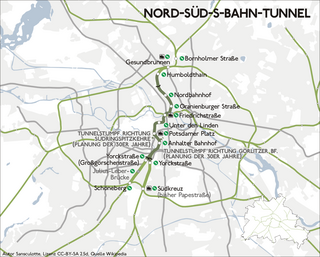
The North–South S-Bahn Tunnel is the central section of the North–South transversal Berlin S-Bahn connection crossing the city centre. It is not to be confused with the Tunnel Nord-Süd-Fernbahn, the central tunnel part of the North–South main line used by intercity and regional trains. The S-Bahn North–South line encompasses the route from Bornholmer Straße and Gesundbrunnen via Friedrichstraße and Anhalter Bahnhof to Papestraße and Schöneberg.

The Wannsee Railway is a suburban railway in Berlin running from Potsdamer Platz via the Ring line station of Schöneberg to Wannsee station on Großer Wannsee, a lake after which it is named. Today it is a section of the Berlin S-Bahn line S1.
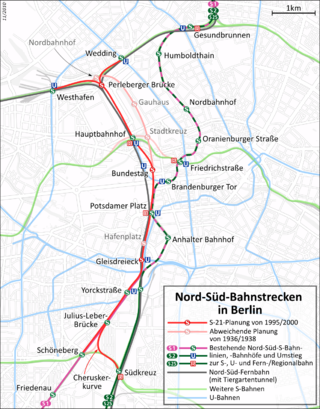
S15 is a planned second north-south route for the Berlin S-Bahn, which will connect Berlin Hauptbahnhof to the Berlin Ringbahn to both north and south. The first section is under construction and is expected to go into operation in 2024.
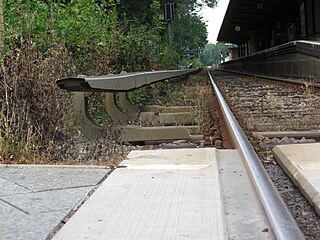
The Berlin S-Bahn began on 8 August 1924 with the first section from Stettiner Vorortbahnhof to Bernau using steam locomotives. On 13 August 1961 it was broken up when the Berlin Wall was built, resulting in two sections: the eastern part and the western part. The western part experienced a massive strike which resulted in closure of several stations, after declining use. Attempts were made to reopen at various times but in the end, only three lines were finally opened after the strike. Since 9 November 1989, when the Berlin Wall was opened, the Berlin S-Bahn began to expand rapidly with their budgetary costs.


















